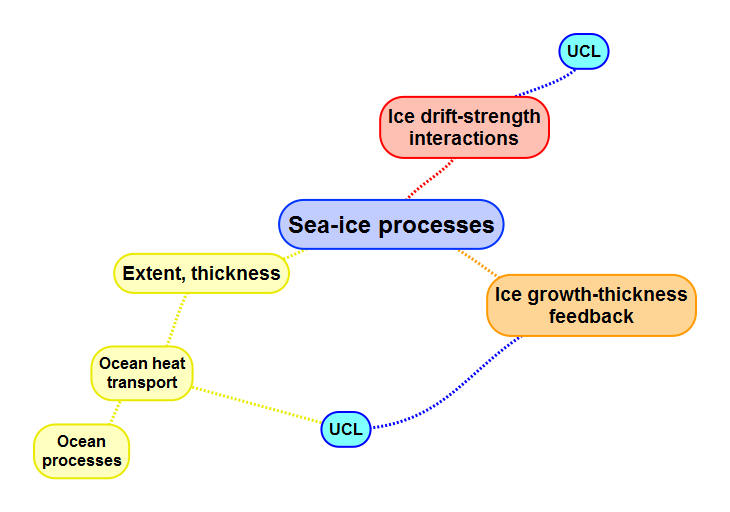
Sea ice processes
The above mindmap is illustrative of the sea ice processes that are important for the Arctic and European climate
Ice-drift strength interactions
In the past decades, the fraction of the Arctic Ocean covered by sea ice has considerably been reduced due to the anthropogenic forcing combined with diverse climate processes (including changes in atmospheric circulation, changes in ocean heat transport and climate feedbacks). This has lead to a reduction in the strength of Arctic sea ice and an enhanced mobility of sea ice (what we call 'sea ice drift'). Within PRIMAVERA, we have developed diagnostics and metrics to better understand the complex relationships between sea-ice drift and strength. We show that some models can reasonably represent the drift-strength relationships compared to observations, while other models have stronger biases. Further details about these processes and tools can be found in Docquier et al. (2017).
Ice growth-thickness feedback
A well-known feature of the Arctic climate is the existence of a powerful positive ice-albedo feedback. Less known is the existence of a set of strong negative feedbacks that mitigate the sea-ice loss in response to external forcing. The simplest of these feedbacks is the ‘negative ice growth - ice thickness feedback’: since heat conduction fluxes are inversely proportional to sea-ice thickness (all other things being equal), thin ice has a tendency to grow faster than thick ice. Within PRIMAVERA, we constructed a diagnostic to measure this feedback indirectly. Further details about this feedback can be found in Massonnet et al. (2018).
Ice-ocean heat transport links
The recent observed sea-ice reduction in the Barents Sea occurred concurrently to an increase in poleward Atlantic ocean heat transport. Other regions of the Arctic Ocean have also recently experienced an increased influence from the Atlantic Water on sea ice. Within PRIMAVERA, we have developed tools to quantify the relationships between sea-ice area/volume and Atlantic ocean heat transport. We show that a higher ocean resolution leads to a reduction in sea-ice area and volume and to an increase in Atlantic ocean heat transport. We also show that every PRIMAVERA model shows a strong anti-correlation between sea-ice area and ocean heat transport.
